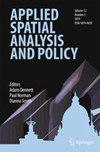Digital economy and urban settlement intentions of rural-to-urban migrants in China: Empirical evidence from quasi-natural experiments
Abstract
Although there has been a large body of studies examining the determinants of urban settlement intentions of rural-to-urban migrants, little attention has been concentrated on the role of technological advances, particularly digital technologies. Drawing on nationally representative data and employing a difference-in-differences (DID) method, we investigate the impact of China’s recent digital economy development on the urban settlement intentions of rural-to-urban migrants. We find that the development of the digital economy has a significant positive impact on the urban settlement intentions of rural-to-urban migrants. This result is robust to several sensitivity tests of the empirical specification. Heterogeneity analyses demonstrate that this positive effect is more pronounced for the new-generation and highly educated rural-to-urban migrants. Further analysis indicates that the mechanisms underlying the increased urban settlement intentions include the accumulated human capital, the improved quality of the environment and the relaxation of hukou qualifications.

 求助内容:
求助内容: 应助结果提醒方式:
应助结果提醒方式:


